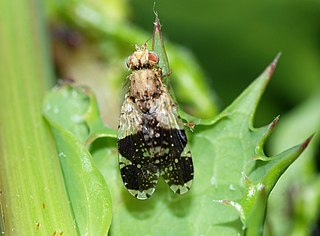
The Pyrgotidae are an unusual family of flies (Diptera), one of only two families of Cyclorrhapha that lack ocelli. Most species are "picture-winged", as is typical among the Tephritoidea, but unlike other tephritoids, they are endoparasitoids; the females pursue scarab beetles in flight, laying an egg on the beetle's back under the elytra where the beetle cannot reach it. The egg hatches and the fly larva enters the body cavity of the beetle, feeding and eventually killing the host before pupating. In the United States, some species of Pyrgota and Sphecomyiella can be quite common in areas where their host beetles are abundant. Like their host beetles, these flies are primarily nocturnal, and are often attracted to artificial lights.

Acinia is a genus of tephritid or fruit flies in the family Tephritidae.
Baryplegma is a genus of tephritid or fruit flies in the family Tephritidae.
Actinoptera is a genus of tephritid or fruit flies in the family Tephritidae.

Metasphenisca is a genus of fruit flies in the family Tephritidae. There are at least 25 described species in the Afrotropical and Oriental Regions. Of these, 20 occur in the continental Afrotropics and two are confined to Madagascar; three species occur in the Arabian Peninsula.
Oedaspis is a genus of tephritid or fruit flies in the family Tephritidae.
Pseudeutreta is a genus of tephritid or fruit flies in the family Tephritidae.

Tephritis is a genus of flies. It contains around 170 described species, making it the sixth largest genus in the family Tephritidae. Many more undescribed species are known from specimen collections. Tephritis occur throughout much of the world, but most are Palearctic. They can be found in a wide range of climate types, from hot semidesert to tundra. Most species inhabit the inflorescences of plants from several tribes in the family Asteraceae, and a few species cause galls to form.

Tomoplagia is a genus of tephritid or fruit flies in the family Tephritidae.

Urophora is a genus of tephritid or fruit flies in the family Tephritidae.
Pseudoedaspis is a genus of tephritid or fruit flies in the family Tephritidae.
Rhochmopterum is a genus of tephritid or fruit flies in the family Tephritidae.

Trupanea is a genus of tephritid or fruit flies in the family Tephritidae.

Xanthaciura is a genus of tephritid or fruit flies in the family Tephritidae.

Sphenella is a genus of the family Tephritidae, better known as fruit flies.
Eutreta is a genus of the family Tephritidae, better known as fruit flies.

Acrotaeniini is a tribe of tephritid or fruit flies in the family Tephritidae.

Cecidocharini is a tribe of tephritid or fruit flies in the family Tephritidae.
Cecidochares connexa is a species of tephritid or fruit flies in the genus Cecidochares of the family Tephritidae. It is used for biocontrol of invasive shrub Chromolaena odorata.









